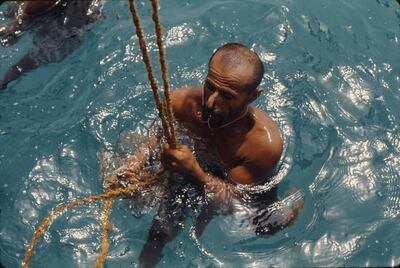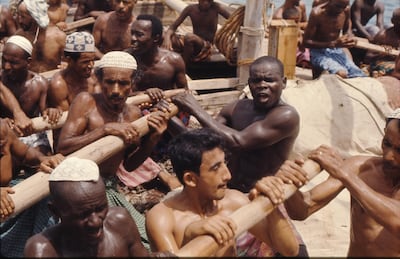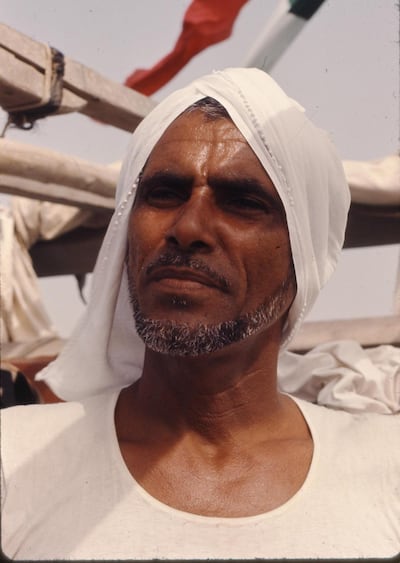In shallow waters just off the coast of Abu Dhabi, the crew of a pearling sambuk dhow prepares to put out to sea.
Muscles gleaming with sweat, some pull on the huge oars, while others carry the heavy main sail to haul up the mast, as a drummer beats out a rhythm for their work.
Nets already hanging over the side of the boat, for the divers it is a time to rest before their difficult and sometimes dangerous work. They relax with a cup of freshly brewed gahwa and a puff of dokha tobacco from a medwakh pipe.
Taken more than 50 years ago, these images recall the golden age of pearling, although by then the industry was all but extinct. Today, though, there is a real prospect that a demand for natural pearls is sparking a revival, particularly in Bahrain, the historic centre of pearl diving in the Arabian Gulf.
Bahrain’s Institute for Pearls and Gemstones (DANAT) says it significantly increased the number of diving licences it issued in 2021, including for the first time, female pearl divers.

It is a far cry from these images, taken by the late Alain Saint-Hilaire, a French-Canadian photographer, who visited the UAE many times, documenting its people and their lives.
Taken in 1971, they capture a way of life that even then was effectively dead. Once at the heart of the Gulf’s prosperity, pearling was killed off by the Great Depression of the 1930s and the arrival of cheap, mass-produced cultured pearls from Japan.
Its demise caused great hardship in the region, which ended only with the discovery and exploitation of oil and gas, first in Bahrain in the 1930s, but as late as 1958 in Abu Dhabi.
In this context, the appearance of a fully rigged and crewed pearling boat in the 1970s is something of a mystery.
Professor Rob Carter, of University College London, is a historian specialising in the Arabian Gulf and the author of Sea of Pearls, which tells the story of pearling from ancient times to its eventual decline.
He believes the 1971 photographs are a reconstruction of a pearling voyage, albeit with a real dhow and a crew, including divers, who once worked in the industry.
There are clues, he says, in the age of those working the boat, many of whom seem past retirement age, and the presence of young boys who may well be their children and even grandchildren.
The dhow also seems to have travelled only a short distance to shallower waters, rather than make the long journey to the deeper beds off Bahrain. This is where the Ghous Al Kabir, or Great Dive, took place in the hot summer months — and also a time when a western photographer would be unlikely to visit.
He points to the handful of pearls supposed gathered during this brief expedition. “Those pearls are all too big,” Prof Carter says. “You will normally only get pearls that big and that good, maybe two of them per boat in a whole season. So it looks to me that they borrowed some nice pearls.”
Still, in every other respect, this is exactly how a real pearling expedition would have looked. “Clearly all the equipment is there. The guys manning the boats know what they're doing. The divers know what they're doing,” says Prof Carter.
It is, he says, a remarkable window to the past. “You see people doing what they've been doing for hundreds of years, but actually, probably thousands, using those same techniques.
“I don't think the techniques would have changed at least since the 9th century. And they might go all the way back to the Hellenistic period, or Bronze Age even — we just don't know.”
The modern history of pearling and its decline is much better known. Gulf pearls were long prized for their beauty both in Europe and the USA, as well as for centuries in Asia.
But the Japanese technique of producing cultured pearls created a mass market for something once rare and precious; while the global economic crash of the 1930 meant even the wealthy now thought twice about buying expensive jewellery.

The combination spelt ruin for the pearling economies of the Gulf, in Abu Dhabi, Sharjah and Dubai, Qatar and the centre of the trade, Bahrain.
Crews often borrowed money in the hope of a payday from a successful voyage. But, as prices crashed and demand slumped, they found themselves plunged into debt.
The arrival of oil, and the jobs and income it provided, turned economic fortunes around. Not that many mourned the demise of pearling once new opportunities presented themselves.
“There was no sentimentality; they gave it up as soon as they could,” says Prof Carter.
“Then once there was a bit of distance, there was a certain amount of nostalgia for the camaraderie that you get on the boats. But at the same time, there will be comments about how horrible it was.
“For most of the pearl divers, you'd be stuck on a boat for basically four months, with maybe only one brief visit home in the middle, eating the lowest grades of foods that could be tolerated, with fresh fish, but old rice and dates and barley.
“Those haulers would be out there, doing heavy labour all day in 49 degrees centigrade, and would only get one or two small cups of water a day.
“And if you got sick, they wouldn't take you home to a doctor. You would just die on the boat, because they had to get on with pearl diving.
“It was not a nice profession. It was tough. They all say that. Towards the end of the industry, they made very little money, or they ended up permanently in debt, so they were glad to be shot of it.”
Yet the region’s deep connection with the pearl continues. Demand still exists for Gulf pearls, which have a unique beauty and character that cannot be matched by the cultured variety. For years, jewellers were able to draw from unsold stocks kept by merchants after the great decline. More recently, they have been able to find pearls in older pieces from India.

They are extremely valuable. A pair of natural pearl and diamond earrings sold for Dh1.2 million at an auction in Switzerland two years ago, while in 2018, a pearl and diamond pendant that belonged to French Queen Marie Antoinette, fetched a record $36m (Dh11.75m).
But demand now outstrips supply. And with it has come a revival in the industry, with modern and safer diving equipment. Bahrain — which still bans the sale of cultured pearls — is now once again the centre of Gulf pearling, with plans to open a “Pearling Path” with visitors' centre and a renovation of the old Muharraq Souq this year.
As well as tourist attraction, natural pearls are becoming big business, attracting interest from the most exclusive jewellers.
In November 2019, a Bahraini diver, Sanad Abdullah bin Juffin, brought up two massive pearls on oyster beds to the north of the island. While the average size of Bahraini pearls is between one and two carats, these were 18 and nine-carat giants and extremely valuable.
So long hidden beneath the waves, could it be that pearling is rising to the surface again?






